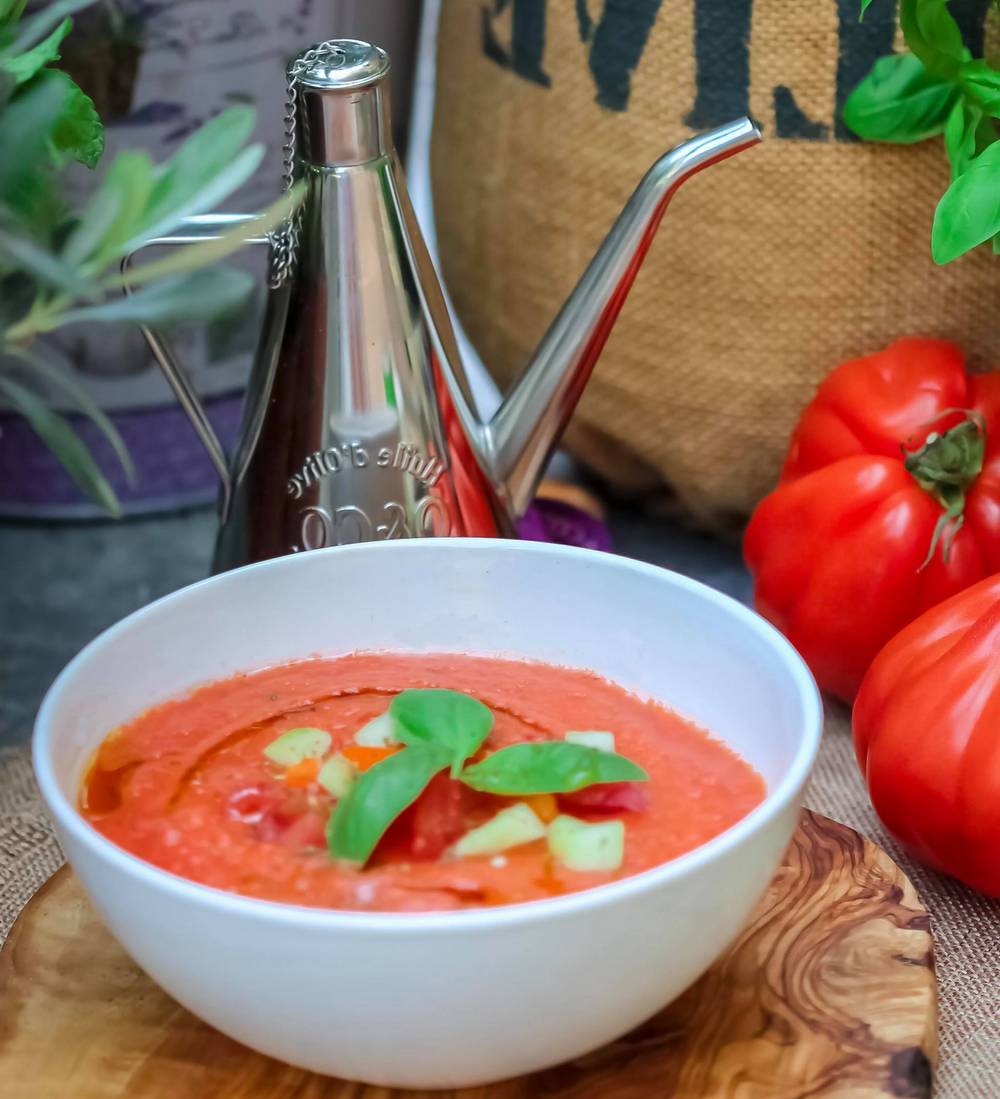Several times, you might not feel like turning on the stove to cook, but you know you must eat, Gazpacho could be the solution you have been looking for. Gazpacho is mostly designed for patio and sunshine. You can cook a large batch of freshly heart soup without you heating up anything or perhaps, feel any weight of any winter soup.
You might be wondering whether or not you can proceed to freeze your gazpacho. Gazpacho in a large batch can be frozen so that it can last you the whole summer. It is quite simple to freeze smooth gazpacho and to also thaw beautifully that will make it seem just like it has just been freshly made. Chunky gazpacho can also be frozen but it will not have a pleasant texture. What we want to do is to show you how you can make your gazpacho and how you can also store it. Please continue reading to get all the needed insight.
Your Guide to Freezing Gazpacho
Originated from Spain, the region Andalusian to be specific, gazpacho is considered as a cold soup. The soup got influenced by dishes from the Middle East and Eastern Europe. This makes it certain that you will get to see various ingredients and rich flavors in the versatile meal. The traditionally known gazpacho was gotten by the mashing of stale bread in a mix of water, vinegar, garlic, and olive oil, and then by adding nuts and vegetables into the broth. The soup was a hearty soup where whatever vegetable can be added and it is an excellent way to make use of your old bread for it not to turn to waste.
In recent times, the more modern gazpacho has its base made out of tomatoes and it has been occasionally referred to as liquid salads with avocado, sweet onions, bell peppers, and cucumbers being added to the broth. You can make the soup completely from raw ingredients and you could sauté some herbs, garlic, and onions to provide the soup with an addition of caramelized flavor before it is chilled. While some people prefer their gazpacho heartier and chunky, others blend all the ingredients together. You are allowed to make your personalized or favorite recipe because it is an individual soup that allows such an experiment.
How To Freeze Gazpacho
Because gazpacho is so simple to cook and very easy to carry, you might have made excess of gazpacho that cannot be eaten immediately, the best bet is to freeze them if you don’t want them to waste. Depending on if you left your gazpacho chunky or you blended it smooth, you have to follow different techniques and that’s why we have made this guide to show you the different paths.
How to Freeze Chunky Gazpacho
You have to first consider the type of chunks present in the soup before you freeze your chunky gazpacho because the chunks may freeze well or they may not and this varies based on the personal recipe. Check below for some of the general rules you should know:
- Chunky bread pieces: they will not freeze quite well because they will get disintegrated into to have a texture that is very odd in the soup. This will not cause a problem if you can blend the soup after you thaw it.
- Vegetables that have a high content of water: they do not freeze well due to the formation of ice crystals and this will leave them unappealing and mushy. Because the whole mix is liquid, it is unlikely to happen inside a soup but it is still not recommended to freeze cucumber.
After considering this, you can then consider using the methods that will be discussed in how you can freeze your smooth gazpacho below.
How to Freeze Smooth Gazpacho
The best thing to do is to freeze your gazpacho in containers you can serve many people or freeze it inside single-serving containers to make serving very easy later. This means you wouldn’t need to defrost all the gazpacho when you want to eat and you will also have several leftovers enough so that you are not tempted to attempt refreezing your soup which is not acceptable.
As earlier recommended, separate it into the serving sizes, after that, pour the soup inside a freezer-safe Tupperware container or a Ziploc bag. A glass container is most preferably used for the Tupperware container. If you have stored the soup inside your glass Tupperware container, ensure you allow around an inch of space at the top because the soup will expand a little.

You should carefully lay your Ziploc bag flat on the counter so that you can remove any excess air from it before you seal. Ensure it stays completely flat when you place it inside your freezer, at least making sure it remains that way until it is frozen solid. You can then stand the bag upright so that you can save space after it has frozen. Ensure you write the freezer date on the containers and try eating the soup within six and eight months of freezing.
How to Thaw Frozen Gazpacho
The best thing is to be aware before the time you want to consume the gazpacho so that it can be allowed to thaw inside the fridge. Because the soup is usually served cold, you will not want to defrost it inside a microwave. You could also allow it to defrost 90 percent on a counter so that you can save time and you can then finish the process of thawing inside the fridge. The easiest thing to do is to thaw the soup overnight, i.e. a day before eating it.
For a frozen smooth soup, that was blended before frozen, you could re-blend it to reintegrate the ingredients together and smooth everything that has been frozen over time. For chunky gazpacho, stir it very well before you serve it. It is not all the chunks that will retain the texture, you should try to taste your soup before you serve and try to compare it with serving smooth gazpacho. The thing you can do is to blend the soup smooth and proceed to add to your soup some fresh herbs or vegetables.
Alternative Ways to Store and Use Gazpacho
You can also store your gazpacho in a fridge where it can stay very fresh for about five days if stored properly in an airtight Tupperware container. You are recommended to use a glass container to store the soup because some ingredients used like tomatoes will stain the plastic. Furthermore, storing liquids inside plastics for a long time will increase the possible risk of harmful toxins getting into the food. In case you do not want your leftover gazpacho frozen and you will not be eating all the leftovers, check below for some creative ways for you to use it:
- Pour it into a blender and add fresh fruits to make yourself a smoothie
- Add some of the gazpachos in your deep pan, simmering chicken breasts or a fillet of fresh fish.
- You can cook pasta noodles before using the gazpacho as the sauce for the cold pasta salad.
- Pour it in a slow crockpot or cooker and add some rice, beans, and perhaps, meat to make yourself a hearty stew.
Related Questions
What goes good with gazpacho?
Your gazpacho is a perfect meal for a very warm summer day. Being a Spanish cuisine that has a slight feel of Mediterranean, the best meals to serve them should be fresh and cool. You can use chopped salads that have plenty crispy of veggies to eat the soup. Bean salad or quinoa can also be eaten to add a bit of something heavier and a bit more fitting. You can also use a freshly-baked baguette by dipping into balsamic vinegar and olive oil.
Is gazpacho the main dish?
Gazpacho can be served as a main dish, side dish, and a tapa if you want to feel Spanish. A tapa is considered to be a small meal or an appetizer in Spain. You can eat gazpacho for your afternoon snack and you can serve it as a side dish or a bowl as a starter.
You may add bulk of fresh and raw ingredients if you wish to use your gazpacho as a feature. The raw ingredients should be higher in protein or fat. This could be seeds and nuts, sashimi quality tuna or salmon, or avocado.
How long will gazpacho keep in the refrigerator?
This depends on the ingredients you have used and if the soup is chunky or smooth. Generally, gazpacho should last in the fridge for about four to five days. If what you have is chunky that includes tender vegetables such as cucumber, then they might wilt and become a little soggy after one or two days. If it is avocado that is included in the soup, the aftermath may be a bit brown, though, acids in the tomato may keep it fresh fairly. Endeavor to check the soup after some days so that you can ensure that it remains very fresh and that the smell is still delicious.


